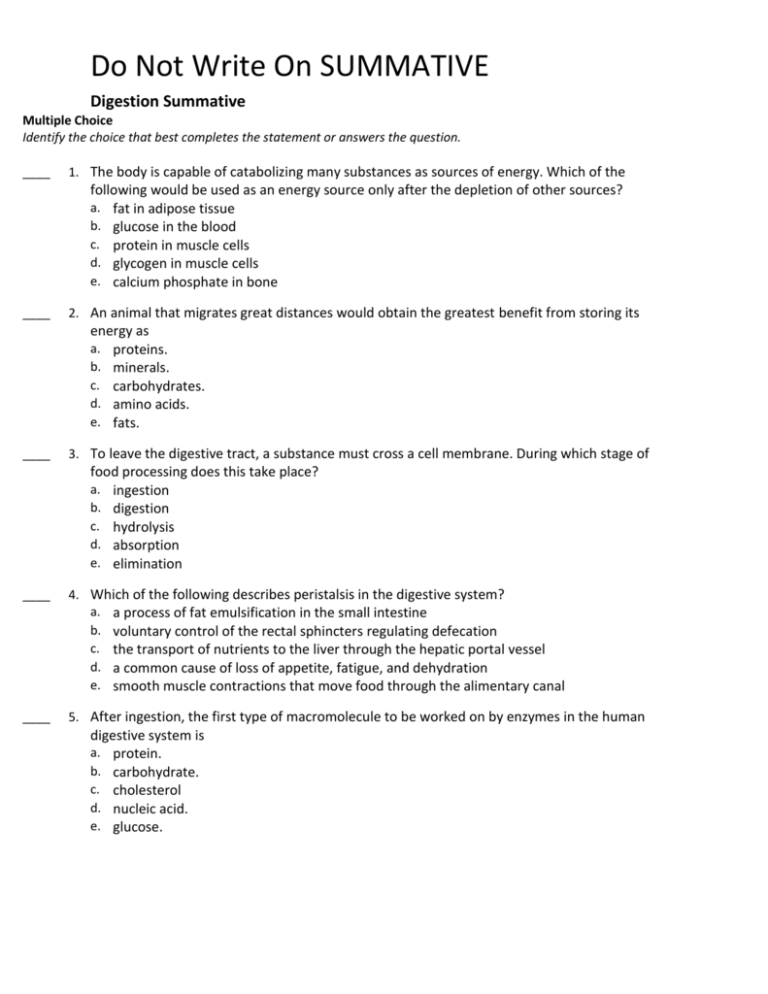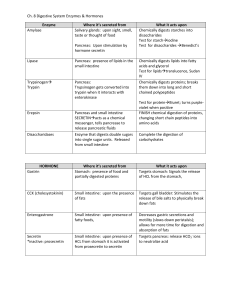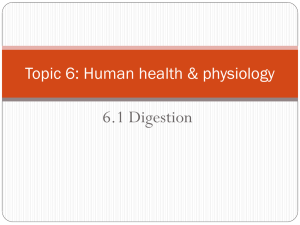File
advertisement

Do Not Write On SUMMATIVE Digestion Summative Multiple Choice Identify the choice that best completes the statement or answers the question. ____ 1. The body is capable of catabolizing many substances as sources of energy. Which of the following would be used as an energy source only after the depletion of other sources? a. fat in adipose tissue b. glucose in the blood c. protein in muscle cells d. glycogen in muscle cells e. calcium phosphate in bone ____ 2. An animal that migrates great distances would obtain the greatest benefit from storing its energy as a. proteins. b. minerals. c. carbohydrates. d. amino acids. e. fats. ____ 3. To leave the digestive tract, a substance must cross a cell membrane. During which stage of food processing does this take place? a. ingestion b. digestion c. hydrolysis d. absorption e. elimination ____ 4. Which of the following describes peristalsis in the digestive system? a. a process of fat emulsification in the small intestine b. voluntary control of the rectal sphincters regulating defecation c. the transport of nutrients to the liver through the hepatic portal vessel d. a common cause of loss of appetite, fatigue, and dehydration e. smooth muscle contractions that move food through the alimentary canal ____ 5. After ingestion, the first type of macromolecule to be worked on by enzymes in the human digestive system is a. protein. b. carbohydrate. c. cholesterol d. nucleic acid. e. glucose. Do Not Write On SUMMATIVE ____ 6. What is the substrate of salivary amylase? a. protein b. starch c. sucrose d. glucose e. maltose ____ 7. What part(s) of the digestive system have secretions with a pH of 2? a. small intestine b. stomach c. pancreas d. liver e. mouth ____ 8. Which of the following statements describes pepsin? a. It is manufactured by the pancreas. b. It helps stabilize fat-water emulsions. c. It splits maltose into monosaccharides. d. It begins the hydrolysis of proteins in the stomach. e. It is denatured and rendered inactive in solutions with low pH. ____ 9. Which of the following is true of bile salts? a. They are enzymes. b. They are manufactured by the pancreas. c. They emulsify fats in the duodenum. d. They increase the efficiency of pepsin action. e. They are normally an ingredient of gastric juice. The following questions refer to the digestive system structures in Figure 41.1. Figure 41.1 Do Not Write On SUMMATIVE ____ 10. Where are the agents that help emulsify fat produced? a. 1 b. 2 c. 3 d. 8 e. 9 ____ 11. Where does the complete digestion of carbohydrates occur? a. 3 only b. 4 only c. 1 and 4 d. 3 and 4 e. 1, 3, and 4 ____ 12. Where does the digestion of fats mostly occur? a. 3 only b. 4 only c. 1 and 4 d. 3 and 4 e. 1, 3, and 4 ____ 13. Which structure is home to bacteria that produce vitamins as by-products of their metabolism? a. 3 b. 4 c. 5 d. 7 e. 8 ____ 14. Adult lampreys attach onto large fish and feed regularly on their body fluids. Given this continuous supply of food, which one of the following is most likely missing in lampreys? a. liver b. pancreas c. intestine d. stomach e. gallbladder ____ 15. Which of the following would probably contribute to constipation? A substance that a. contains plenty of fiber. b. promotes water reabsorption in the large intestine. c. speeds up movement of material in the large intestine. d. decreases water reabsorption in the large intestine. e. stimulates peristalsis. Do Not Write On SUMMATIVE ____ 16. Which of the following are adaptations to a carnivorous diet? a. broad, flat molars b. a rumen c. ingestion of feces d. bile salts e. amylase ____ 17. In which of the following would you expect to find an enlarged cecum? a. rabbits, horses, and herbivorous bears b. carnivorous animals c. tubeworms that digest via symbionts d. humans and other primates e. tapeworms and other intestinal parasites ____ 18. The mammalian trachea and esophagus both connect to the a. large intestine. b. stomach. c. pharynx. d. rectum. e. epiglottis. ____ 19. Which of the following enzymes works most effectively at a very low pH? a. salivary amylase b. trypsin c. pepsin d. pancreatic amylase e. pancreatic lipase ____ 20. Which of the following organs is incorrectly paired with its function? a. stomach–protein digestion b. oral cavity–starch digestion c. large intestine–bile production d. small intestine–nutrient absorption e. pancreas–enzyme production ____ 21. After surgical removal of an infected gallbladder, a person must be especially careful to restrict dietary intake of a. starch. b. protein. c. sugar. d. fat. e. water. Do Not Write On SUMMATIVE ____ 22. If you were to jog a mile a few hours after lunch, which stored fuel would you probably tap? a. muscle proteins b. muscle and liver glycogen c. fat stored in the liver d. fat stored in adipose tissue e. blood proteins ____ 23. Celiac disease causes the destruction of the villi cells. Which of the following is most likely to happen to people with celiac disease? A. Incomplete digestion of fats B. Poor absorption of calcium C. Increased levels of glucose in blood D. Damage in the esophagus caused by increase in acid content of the stomach ____ 24. A. B. C. D. What is the main function of the large intestine? Absorption of water Digestion of fats and proteins Absorption of nutrients Recycling of digestive enzymes ____ 25. During digestion, proteins are broken down to a. simple sugars c. amino acids b. carbohydrates d. ATP ____ 26. During digestion, carbohydrates are broken down to a. simple sugars c. amino acids b. proteins d. ATP










